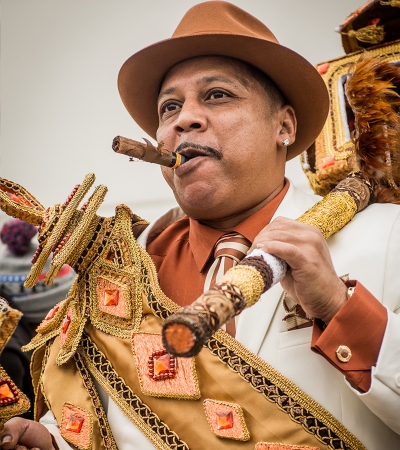Larry Terrance is the founder of the Spirits 2 Da Street. He’s my wife, Denise Smith’s, cousin. Just like I was fascinated with Indians, he had a love for second lines. He was parading with The Old and the Nu Style Fellas when God gave me a vision for him to form his own where he could express his creativity.
At first, he said, “I don’t know.”
I told him, “If you love it that much, you’ll give it some thought.” He told me, “I’ll parade, if you parade with me, Chief. And I’m gonna mask with you.” He never masked in his life, but he put a suit on to mask with my gang. I said, “Okay, deal.”
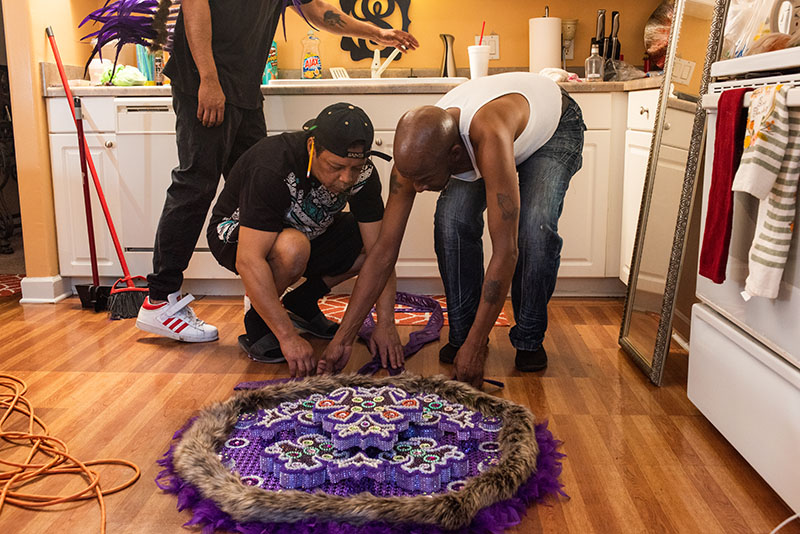
I grew up in the Seventh Ward, on Pauger and Urquhart. I was raised up in Tamborine and Fan, a community center that kept a lot of people alive. We could have lost our lives because there was poverty and drugs in the streets, but Jerome Smith and them created other opportunities for us. Jerome was affiliated with Big Chief Allison “Tootie” Montana and the Yellow Pocahontas. He also created a social and pleasure club called the Bucketmen. Half of the guys I grew up with paraded, and the others were in the Indian culture.
At ten years old, I saw the Yellow Pocahontas coming down the side streets of the Seventh Ward. I didn’t know what they were, but the colors fascinated me. I thought they were gods. They captured my spirit, and I’m like, “I want to do that!” I’ve stayed with it all these years. Some of the people who paraded with the Bucketmen—Bernard Robertson, David Crowden, Adrian “Coach Teedy” Gaddies—went on to start Sudan. When the Bucketmen went out, Sudan came in.
When Larry told me he was ready to start a second line club, I said, “When you parade, you have to find a spot on a Sunday.” The city couldn’t give him a day on his own, and he couldn’t find another club to parade with, so God looked at me again. I thought, “Okay, I grew up with David and Bernard, and what would be better than to parade together in the Seventh Ward?” Larry and I went to Sudan and talked to them about joining their parade. They said yes with open arms. All this is home grown. I tell them that today, “Y’all are a remake of the Bucketmen.”
Larry is a church guy. He was about the spirit telling him he could do it, so he named the club “Spirits 2 Da Street.” It’s his dream, I’m just helping him fulfil it. We hit the streets in 2015. He creates everything at his house. I help design, but it’s all Larry’s ideas. I sit here with him—days and nights—and, under his supervision, we will put it together.
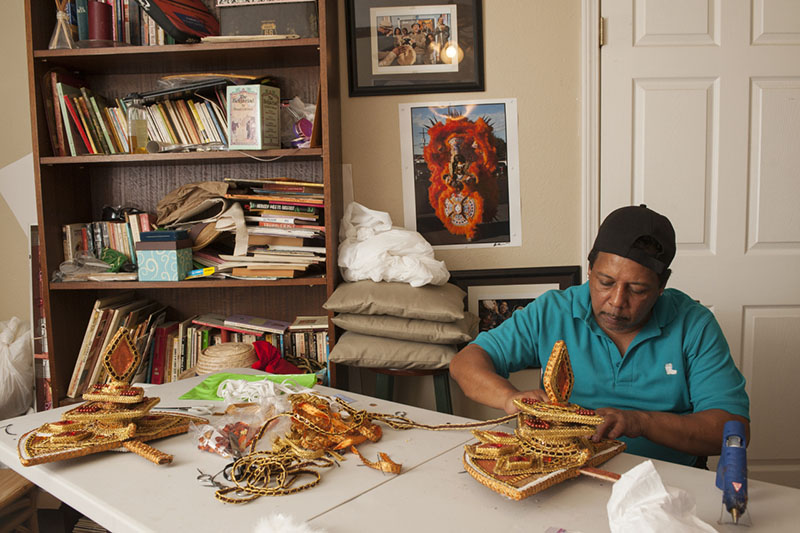
You know, I’m a teacher. I love for you to sit down and do something. You mess it up, it ain’t no problem. We gonna fix it. And that means next time you do something, you already know. You’re going to be saying, “Chief, look what I did.” Even though you got members in your club, Larry is not one to let them do anything. He wants to do it all because if he does it all, he knows it’s done right. I learned how to pay attention to all of the details through years of sewing.
Getting in the Street
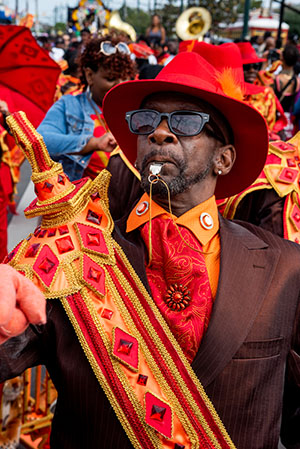
When I was growing up, a lot of people backed away from and feared the Indians. As kids, we weren’t allowed to participate. When the Indians passed, we had to stay on the stoop. Moms wouldn’t let you in the street. The Yellow Pocahontas wanted to see the pretty White Eagles and the Creole Wild West, and they wanted to see them. Big Chief Jake and Tootie were like this [fingers crossed]. Even though they were rivals, and their styles of sewing were different, they hung out in barrooms. They got along because everybody loved what they were doing.
Lil Jerome Smith Jr. was the same age as me. He was my best friend. He opened the door for me because he was masking as Little Chief of the Yellow Pocahontas. I told him, “Man I want to do that!” He said, “I’m gonna take you around the corner to my uncle house.” It was Melvin Reed, truly the best person that never put an Indian suit on. Hands down the master. Back then, just about the whole Yellow Pocahontas tribe, from spyboys and flagboys, was designed by Melvin Reed.
I was eleven the first year I started masking. The first suit wasn’t made by me. It was made by my uncle, Junior Landry, because I was a little boy and didn’t know how to thread a needle. My mama and them paid him to make it. Jerome had a building on North Robertson Street, and we would get out of school and help work on the second line designs. I began to see how they were sewing, too. I was watching Melvin Reed and what Big Jerome did with Lil Jerome. “How they did the triple bead and little bead?” They told me, “If you want to look a certain way, you got to be able to learn and do it for yourself.” The second year, I picked up on everything, which gave me the green light. On Saint Joseph’s Night, we would parade to the International Longshoremen’s Association’s auditorium where we had competitions for the best suits. The third year, I won my first trophy as a spyboy. From 12 years old until now, I’ve made my own suits.
As I was getting involved, Tootie was changing the game. The Yellow Pocahontas was sewing so much it made it a competition around who could sew the best. Back then, there was a lot of teaching from other guys who masked, too. Fred Johnson was a spyboy for the Yellow Pocahontas. He’ll probably be the best spyboy who ever put a suit on. He never came out of his position. Some people move down the line, going from one position to the next, but Fred and Franklin “Wingy” Davis never came out of their positions, so they were teachers. I masked spyboy for years under them. Then I went from a spyboy to a flagboy under Victor Harris and Anthony “Meathead” Hingle. Anybody can put a suit on, but this thing calls for loyalty.
The people who were masking with Tootie—Fred, Wingy, Meathead, Vic, Collins Lewis—they were also teaching the Tamborine and Fan’s NORD program at Hunter’s Field. I didn’t like playing football. The NORD thing wasn’t for me. I didn’t like running around like that. My eyes would zoom on the prize to the Indian culture. These guys implemented Jerome Smith’s footwork. These guys were teachers; they educated you. They were so strict, if you didn’t follow guidelines, you couldn’t mask with Tootie. You couldn’t parade with the Bucketmen. You had to keep your spirit humble. Sometimes you had to leave your own suit alone, because you were ahead and were asked to help others. Some people were like, “Oh, I would never stop sewing.” No: “We have to get him straight, you understand? Because you straight.”
As youngsters, we were militants. We did a lot of freedom marching. My house was across the street from Marie C. Couvant, where Tamborine and Fan had the day camp. We marched from the school to City Hall. We sat in on the floor in City Hall because we wanted the rights to have the Super Sunday.
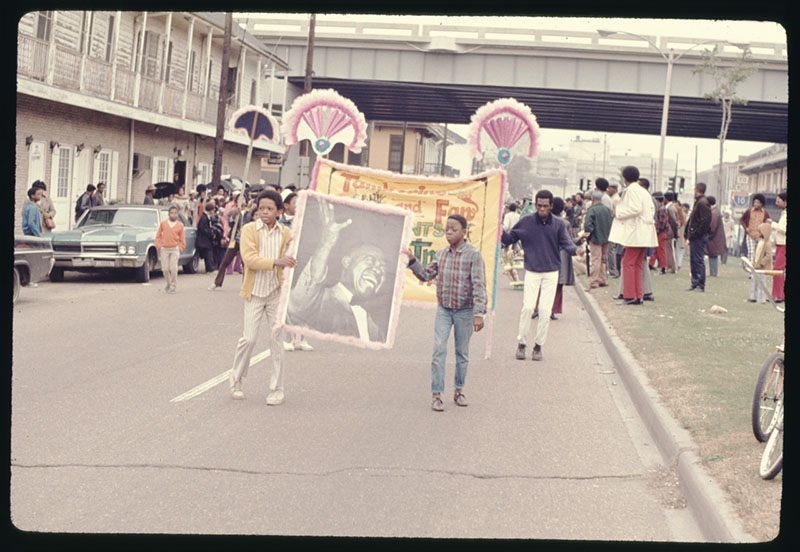
We wanted the rights to be ourselves on Saint Joseph’s Night. We marched when they were trying to cut funding for the NORD programs. We learned discipline: No moving, no arguments, no fighting. Judge Edwin Lombard was a member of the Bucketmen and sat on the criminal court judge court. A lot of times you had a lot of kids that were dibbling and dabbling, not following the rules. Judge Edwin gave a lot of kids a second chance.
Coach Collins Lewis never put a suit on, but he was always there. Like I tell people, we don’t make these suits all by ourselves. There are other people in the background that help—that be a part of every step you make—and that’s what Coach Collins was. Coach Collins and Sylvester Francis were like brothers. I met Sylvester through Coach. He pushed Sylvester a lot with the Backstreet Cultural Museum. Photographers weren’t plentiful back then. People took a picture with a polaroid camera, but Sylvester would document us. Sylvester would see my suit before anybody else, and I wasn’t the only one he was doing that to. When Victor started Fi Yi Yi with Coach, he would come around and take pictures before your suit hit the street, and then tell you, “I’ll catch you on the street.”
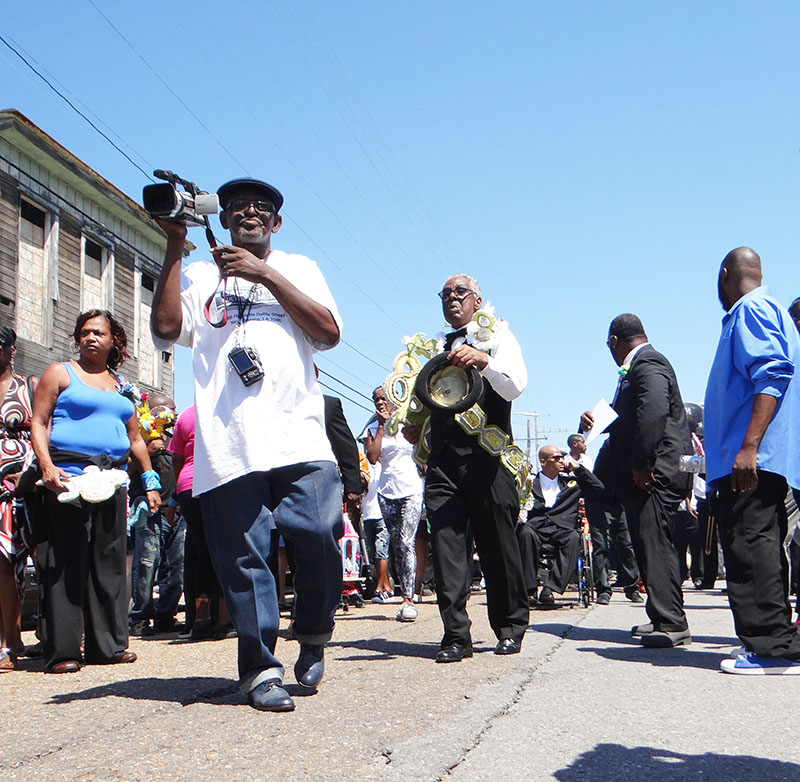
It’s important to remember everything that’s happened—to open up books, community centers, art galleries. We need to understand the history to be able to make better decisions about what we can do today. To get into something, you need to do research. Sylvester with the Backstreet was one of the places where we could take people to see the suits, and to educate on the culture. We need that.
Keeping Family Together
By the late 1980s, early 90s, Tootie had gotten older. It cost a lot of money to mask, and the Yellow Pocahontas was standing in front Tootie’s door all day. We weren’t going into the neighborhood. But Tootie being Tootie, there was no end in sight. People started making other plans. Out of Tootie came all these different tribes: Fi Yi Yi, Apache Hunters, Black Feather. When I left the Yellow Pocahontas, I wanted to give something back to where I came from. If someone branches off with the right spirit and the right heart, you are always going to be mentioned. When Tootie was a little boy, he masked with his dad, they were Monogram Hunters. In 1992, I told Tootie I would name my tribe in honor of this history.
When I was a little boy, Tootie had Indian practice at Pauger and Marais in the Seventh Ward. Fred and them taught me how to dance in that barroom. They taught me how to sing and play my position in that barroom. I went back and asked Ms. Carol if we could hold the practice there again to teach everybody that’s gonna be a Monogram Hunter to follow in this legacy. I want people to feel the spirit in that building, and I try to teach my son, Jeremey, it, too.
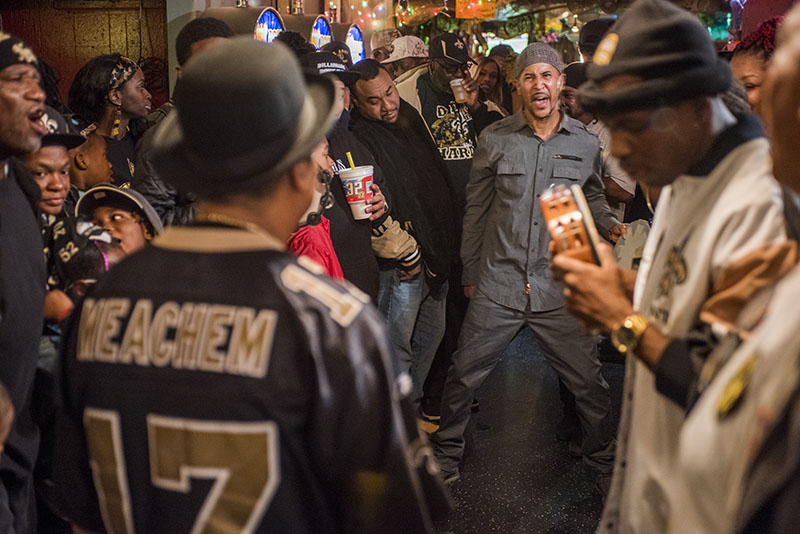
One year, my wife Denise’s grandbaby masked with me, and I showed her how to sew to make the suit for him. She touched it. See, you have to touch it. You have to make mistakes. You have to turn a stone the wrong way, put the pearl in the wrong spot, to learn how it all comes together.
As time went on, I got involved with the Porch Seventh Ward Cultural organization. They wanted me to teach sewing classes, and I stopped sewing for the Monogram Hunters. Denise told me, “Everywhere we go, people wanna know when we putting the suit on.”
She said, “Bae, if you put the suit on, I’m going to mask with you.” We did the black suits. Denise’s big queen suit was just like mine. My nephew, Keelian “Dump” Boyd Young, masked with me for many years, and decided to start his own gang, the Young Messiah Hunters. I’m not angry about none of that. I’m like Tootie. I’m a tree planted by the water, but I got branches. When Monogram Hunters met the Young Messiah, it’s nothing but love. Under the Indian suit, you’re still my flesh and blood. After we take this off, we’re going to sit down and have a drink, eat. He still second lines with us.
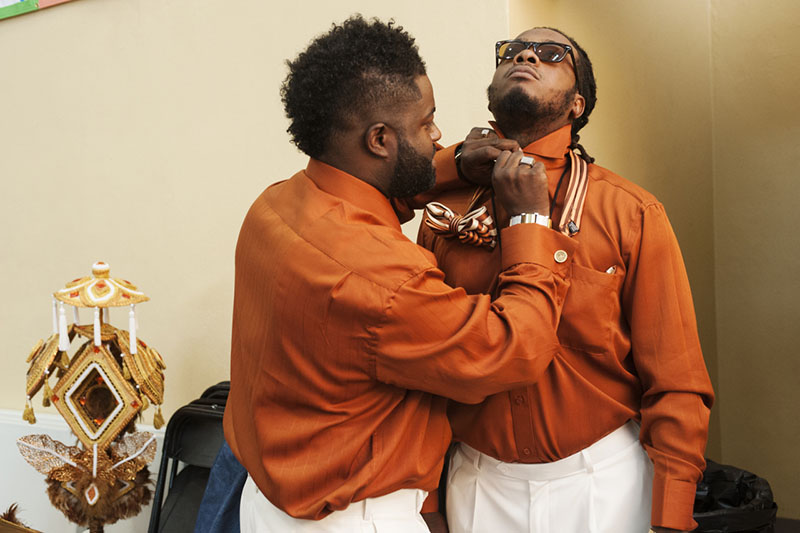
During COVID, my wife and I stayed with Larry, so you’ve got Indian suits being done in the shed, second line designs being done in the house, but it all comes together. Hopefully in 2021, Spirit 2 Da Street and the Monogram Hunters will be back.
'
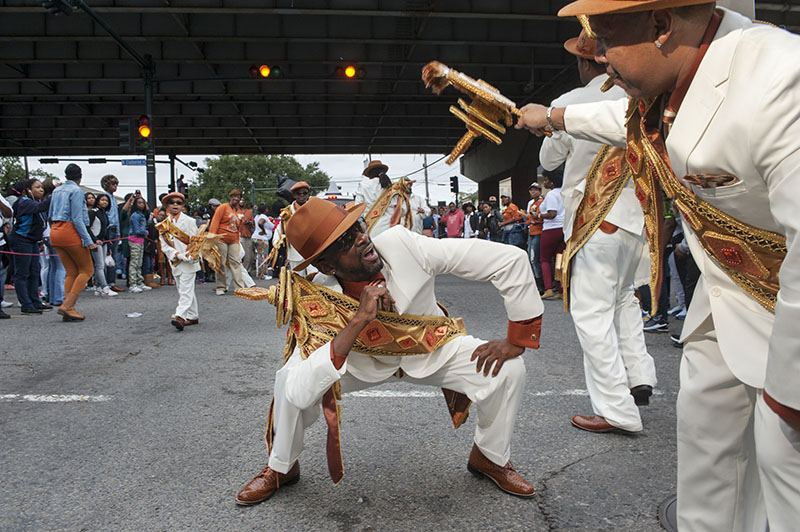
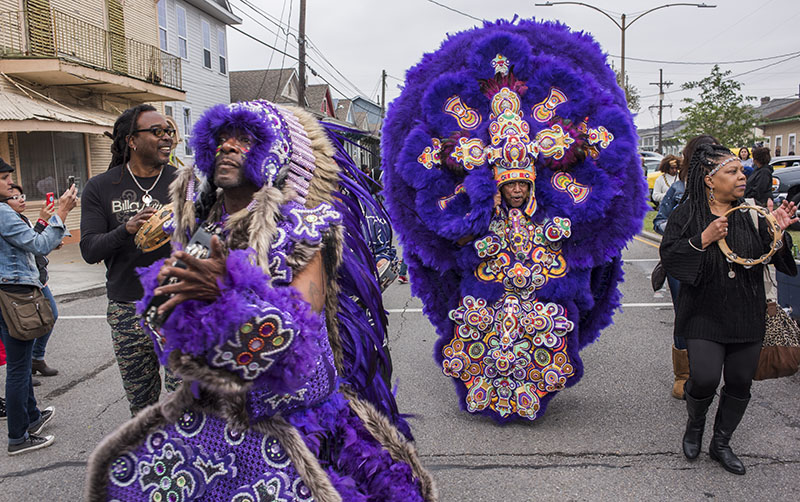
on Carnival day; 2018; by and courtesy of Ryan Hogdson-Rigsbee

